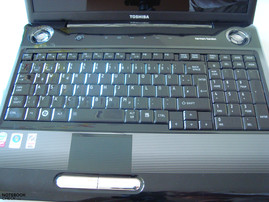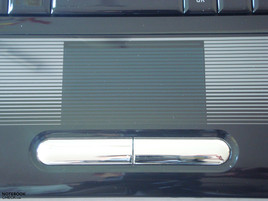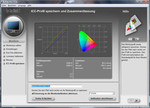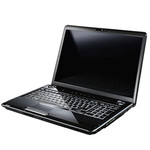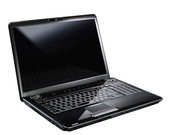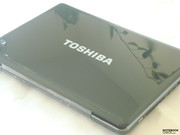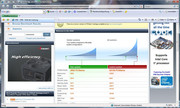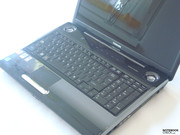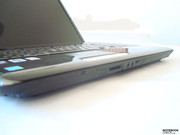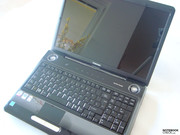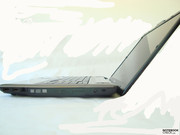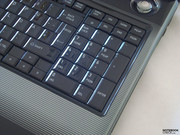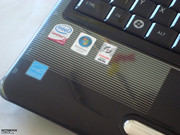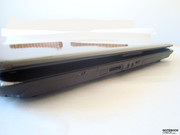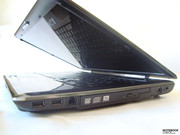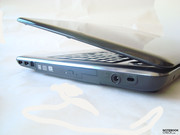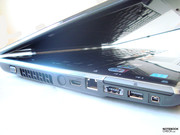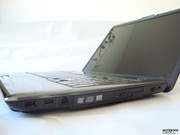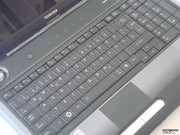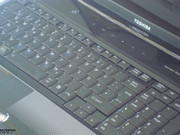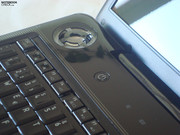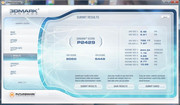Review Toshiba Satellite P300-212 Notebook
Flood of Models
Toshiba continues to expand its range of 17 inch Satellite P300 Series notebooks Among others you find the P300-212 Model equipped with the high-performance Core 2 Duo CPU and no less impressive ATI HD 4650 graphic board. With currently around 20 different configuration possibilities, just about anyone looking for a 17 incher will find a model that suites them.
This review covers the Toshiba Satellite P300-212 which at a nonbinding recommended retail price of 1560 Euros VAT included represents the most expensive notebook in the Satellite P300 series. For that money one gets a technically well-equipped multimedia and work tool with sound hardware utilizing an Intel Core 2 Duo T9550 Processor with 2.66 Ghz, four Gigabyte internal memory (upgradeable to a total of eight GB), a Radeon HD 4650 graphic board from ATI and a single hard drive memory capacity on two seperate 500 GB hard drives. More on that in the conclusion.
Case
Like most manufacturers, Toshiba uses a plastic case with a gloss finish on the P300-212 giving the notebook a certain elegance, at least when the gloss finish is clean and free of fingerprints and dust. Especially the continual opening and closing of the display leave their mark and demand some care in order to maintain that glossy appearance. In terms of colour, the P300-212 is comes for the most part in plain black with the exception of the white Toshiba inscription on the backside of the display cover and the white lines running horizontally in the area of the carpel support.
In regard to the case's stability there is, other than a single point, really no fault to be found. The case buckles somewhat in the area around the internal DVD drive when this spot on the notebook's case is pressed with thumb and forefinger, something which tends to happen when lifting the machine. The slot around the DVD drive seems a bit too large in our opinion. The rest of the case is better armed against such direct pressure and does its job quite well.
Another positive is the visual appearance of the P300-212, which in addition to the black gloss finish also features a striping pattern around the palm rest area. The generous mouse buttons in chrome work well with the whole optical concept and lend an overall subtle yet elegant appearance.
The 17 inch display is connected with a single large hinge, which doesn't take away from its stability. Opening and closing the lid is done easily by hand and without any troubling noises. The P300-212 also gets by well without a complicated and annoying lock mechanism.
One weak point which is found with almost all plastic cases is the backside of the display lid. When transporting the notebook you have to pay special attention to avoid allowing anything to press against the lid as this buckles even under light pressure. In addition to carrying bag or case, an additional cover is definitely advisable. If not only for the display's backside then also for the very sensitive gloss finish, which can easily be scratched during transport.
Connectivity
The Toshiba P300-212 is equipped with the most common connections expected on a notebooks in its class, which are confined to the well- thought out and neatly arranged front and backsides of the notebook housing. Due to the relatively long battery, the backside offers no space for any sort of terminal connection. The interfaces are therefore concentrated on the front and sides.
The front side's connections are very neatly laid out. Next to the switch for the WLAN one finds a card reader (5-in-1 Bridge Media drive - supporting SD™ Cards up to16 GB, Memory Stick® up to 256 MB, Memory Stick Pro™ up to 4 GB, MultiMedia Card™ up to 1 GB and xD-Picture Card™ up to 2 GB), two audio interfaces (Microphone and headset) and the volume adjustment on the front.
The left side houses an analog VGA outlet which supports an external resolution of max. 2048X1536 pixels, a ventilation duct for heat dissipation, a HDMI connector and a LAN port. One also finds an Express Card slot, a combination E-SATA/USB 2.0 port and a further USB slot followed by a Firewire connection.
With these ports, performing every-day tasks should be no problem. The notebook tested had a total of over 4 (left 2, right 2) USB 2.0 with support of the USB Sleep-and-Charge features, with which the batteries of small devices like Mp3 players, digital cameras etc can also be charged while the computer is switched off.
The P300-212 also has an integrated webcam with integrated microphone in the upper part of the display frame making video conferencing via Skype or any similar problem no problem for our test contender.
In terms of its use as a tool for communication, the Toshiba Satellite P300-212 has quite a few things to offer. In addition to the common tethered communication options such as the modem connection (RJ-11) or the LAN port (RJ-45), the test notebook also allows for connecting to other computers of the internet through wireless technologies like WLAN (Wireless LAN (802.11a/g/Draft-N)) or also Bluetooth 2.1 with EDR.
Input Devices
The P300-212 has a well laid out keyboard including a numeric keypad. The individual keys are all in the right spot, namely where one would expect them thus minimizing the time needed to get used to it. Typing is done fluidly and the feeling one gets from typing is just as impressive. The keys offer a clearly noticeable stop-point producing a fair amount of noise when energetically typing, something that isn't really a negative or at least won't be considered irritating. One flaw is the high gloss finish, which is susceptible to easily visible fingerprints when working with it. For reasons on space, the four arrow keys are positioned somewhat lower.
The touchpad is positioned a bit to the left under the keypad. Just under that are the two well-sized mouse buttons with a chrome surface. The surface of the mouse replacement can be described as smooth. It is thus easy to accurately steer the cursor, and the mouse's buttons work just as well. Here too is this type of surface a flaw, as fingerprints and other forms of bits of dirt are quite visible depending on the angle which the light hits it.
Additional input devices, if one can call them that, are found under the display between the two built-in speakers from Harman/Kardon. These keys are pressure-sensitive and offer the most common multimedia functions.
Display
As with most modern displays, the Toshiba Satellite P300-212 we tested also has a reflective 17 inch TruBrite WXGA+TFT display with a max. resolution of 1440X900 pixel. The advantage of the glare display are easily to name, at least when coming from the manufacturers - rich and full colour when compared to the matt displays.
There could be problems with using it outside, especially when the sun is behind the user. Unfortunately, our test machine was no exception. The developers and designers of the P300-212 also haven't configured it for mobility, something easy to notice based on its size, weight and battery life.
| |||||||||||||||||||||||||
Brightness Distribution: 75 %
Contrast: 326:1 (Black: 0.6 cd/m²)
The integrated display impresses with its sharp pictures and full, rich colours, both when watching films and when gaming.
In terms of the brightness, the display can be described as adequate for every-day use. However, the uneven illumination of the integrated panel blurs the overall impression. Our measurements showed a min. of only 146.2 cd/m² in the lower left area of the display, a very modest measurement in our opinion. The max. of 195.5 cd/m² we got for the center or the panel represents a very satisfactory value. This doesn't, however, make up for the rest of the fairly modest measurements of the display's illumination. The four corner are especially affected. With an average brightness of 167.67 cd/m², the P300-212 falls only somewhere mid-pack.
The angle stability, both in the horizontal and vertical planes, is satisfactory, though the vertical viewing area reacts more sensitively to changes in sitting position as the horizontal.
Performance
Thanks to an Intel Core 2 Duo T9550, which goes to work with a frequency of 2.66 GHz, one can not complain about the performance. Helping out are a total of four GB RAM (2X 2048 MB, PC2-6400, DDR2 RAM) from Hyundai Electronics. The graphics accelerator employed in our tester is a Mobility Radeon HD 4650 with 1024 GDDR3 memory and Hyper Memory support. The P300-212 is well equipped for both everyday use and for multimedia entertainment during breaks or in ones free time. Surfing the internet, writing emails, chatting and watching films from the hard drive or DVD present no problem for the machine. Only in the realm of gaming might the performance come up a bit short, which doesn't at all mean the P300-212's gaming abilities are wash. More information and details concerning our test sample and its gaming compatibility will follow.
But first, a few results from our Futuremark benchmark tests with PCMark05 and PCMark Vantage should simplify the comparison between the individual notebooks. With 6625 points for the already obsolete PCMark05 benchmark and 3892 points for the PcMark Vantage, the P300-212 notebook from Toshiba can be quite happy with itself. Also on board is the Cinebench R10 test, which was concluded with 3001 (Single CPU rendering) and 5615 points (Multi CPU rendering). The GPU was rated with 5432 points in the Open GL test.
| PCMark 05 Standard | 6625 points | |
| PCMark Vantage Result | 3892 points | |
Help | ||
| Cinebench R10 | |||
| Settings | Value | ||
| Shading 32Bit | 5432 Points | ||
| Rendering Multiple CPUs 32Bit | 5615 Points | ||
| Rendering Single 32Bit | 3001 Points | ||


As its main mass storage media, two 500 GB hard drives (MK5055GSX) of the marquee's own make are employed. They provide our tester notebook with enough storage for films, MP3s, photos etc. The total capacity of one terabye should, at least "at first", be sufficient. If this turns out not to be the case, there is still the possibility of hooking up an external hard drive; the P300-212 certainly has enough connection options.
Gaming Performance
The gaming capabilities of the P300-212 were also scrutinized. We tested with the shooter Crysis and also with the real-time strategy hit World in Conflict. At least that is how it was planned. Despite numerous attempts, our runs with Crysis resulted each time in a crash.
World in Conflict on the other hand ran without problems. We tested both with DirectX 10 (very high details) and with DirectX 9, which corresponds to a medium setting. The results were not all that suprising. The integrated ATI Mobility Radeon HD 4650 with a Gigabzte GDDR3 memory does not have enough performance to fluidly support WiC in DirectX 10. The average frame rate with World in Conflict with the resolution 800X600 lands exactly by 14 pictures per second - too little for fluid gaming.
It is a different story in DirectX 9. One can clearly see that the DX9 works significantly better with the ATI Mobility Radeon HD 4650. In World in Conflict, the integrated middleclass GPU presented fluid and thoroughly impressive and sharp pictures on the 1440X900 display. Even with this resolution are an average of 48 fps possible, which is more than enough to assure fluid and judder-free gaming.
In principle, the new games are possible on the P300-212, though with graphical drawbacks in the form of reduced clarity, a limited game resolution, or a combination of both. More detailed information about which games with which settings run smoothly can as always be found in our game review.
Even if the run of Crysis didn't exactly go off as planned for whatever reason, it shouldn't be a problem to compare the P300-212 to other notebooks. The 3DMark01, 3DMark03 and 3DMark05 benchmarks coming this year got ratings of 33488, 18838 and 12313 respectively. 3DMark06 gave out 6643 points for the P300-212 notebook while 3DMark Vantage was awarded a total rating of 2429 points with our testing system (GPU 2050, CPU 5449).
| 3DMark 2001SE Standard | 33488 points | |
| 3DMark 03 Standard | 18838 points | |
| 3DMark 05 Standard | 12313 points | |
| 3DMark 06 Score Unknown Setting | 6643 points | |
| 3DMark Vantage P Result | 2429 points | |
Help | ||
Emissions
System Noise
The Toshiba Satellite P300-212 is no whisper-quiet notebook. For those who consider quietness an important feature, our tester will probably be less appealing. This becomes evident even while idling. With an above average 40.7 dB(A), the P300-212 is anything other than a quite companion, even if the fans work unobtrusively and constant. Users who are less sensitive will either block out or hardly notice the buzz of the spinning fans after a certain time getting used to them. The P300-212 turns it up a notch under load and raises its operating volume to a full 45.3 dB(A), which is very difficult to hear over. This does not, however, prove too bothersome when gaming or watching films as the film's or game's background noise is normally louder.
Noise level
| Idle |
| 40.1 / 40.7 / 40.8 dB(A) |
| Load |
| 45.3 / 46.1 dB(A) |
 | ||
30 dB silent 40 dB(A) audible 50 dB(A) loud |
||
min: | ||
Temperature
The on-load operating temperature of the P300-212 stays in the green zone on the upper side of the notebook. We tested the highest values at a comfortable 36.8 degrees Celsius in the middle range on the left side, exactly where the ventilation duct for heat dissipation is located. The underside on the other hand does not fair as well. Especially under extended load it is possible for the underside to reach a high temperature of 45.6 degrees Celsius after over an hour of Prime95/Furmark. Despite the noise of the fans, trying to work with the notebook seated comfortably on your lap becomes at that point impossible and not advisable.
(+) The maximum temperature on the upper side is 36.8 °C / 98 F, compared to the average of 36.9 °C / 98 F, ranging from 21.1 to 71 °C for the class Multimedia.
(-) The bottom heats up to a maximum of 45.6 °C / 114 F, compared to the average of 39.2 °C / 103 F
(+) The palmrests and touchpad are reaching skin temperature as a maximum (34.6 °C / 94.3 F) and are therefore not hot.
(-) The average temperature of the palmrest area of similar devices was 28.7 °C / 83.7 F (-5.9 °C / -10.6 F).
Loudspeakers
As is already known in many Toshiba notebooks, the P300-212 also has a sound system from the prestigious make Harman/Kardon. This bestows the P300-212 with an above-average, good sound playback, whether it is in games, when playing a DVD or music CD or with songs in MP3 format. Though the Altec Lansing system naturally can't compete with a hi-fi unit, it works quite well for notebook standards. No noise or saturation is discernable in the playback, of course depending on the quality of the source, even with maximum output, something that is more than adequate for daily use. The tones are clean and clear. Only the bass comes up a bit flat.
Battery Life
The Toshiba Satellite P300-212 has a Lithium-ion battery from Sanyo with a capacity of 50.4 Wh. Unfortunately, this is not enough to give it an impressive performance on the move, at least under the continued load put on it by this testing system. Under these conditions the attached mobile energy source didn't even last an entire hour. To be more exact, only 54 minutes according to Battery Eater in the Classic test-run. It seems a bit better in the Reader's test-run from Battery Eater, which tested the battery life of the Toshiba Satellite P300-212 at 134 minutes, so 2 hours and 14 minutes. Thus, the notebook is nonetheless far from being useable for mobility.
| Off / Standby | |
| Idle | |
| Load |
|
Key:
min: | |
Verdict
Toshiba equipped the Satellite P300-212 with the newest hardware so that it provides the average use with more than enough computing power to do away with the 0-8-15 applications. In addition to a Core 2 Duo T9550 with 2.66 Ghz from Intel is a ATI Mobility Radeon HD 4650 with 1024 GDDR3 memory on board which supplies the 17 inch Toshiba TruBrite WXGA+ TFT display with pictures. The notebook also has a memory capacity of around a terabyte, which is split between two 500 GB hard drives (Toshiba MK5055GSX) with 5400 rotations per minute. This should offer enough space for the private MP3 or film collection.
In its 17 inch form factor the P300-212 is conceptualized more as a desktop replacement with emphasis being placed on performance and multimedia or as a technical plodder, something that takes away from the life and performance of the battery.
Toshiba delivers the Satellite P300-212 already equipped with a version of Windows Vista Home Premium 32bit as with a 24 month international bring-In factory warranty including an on-sight pick up service for Germany and Austria (by registering the repair on the Toshiba laptop hotline). The non-binding suggested retail price from Toshiba is currently at 1560- Euros VAT included.









